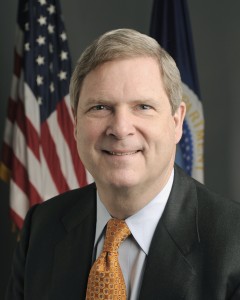Agriculture Secretary Vilsack Announces Climate Smart Agriculture and Forestry Results, Additional $72.3 Million Soil Health Investment to Support Paris Agreement
 Agriculture Secretary Tom Vilsack shared the first results of USDA’s Building Blocks for Climate Smart Agriculture and Forestry, one year after he unveiled the plan at Michigan State University. In addition to providing specific goals and results of the many actions that USDA is taking to help farmers, ranchers, and forestland owners respond to and help mitigate climate change, Vilsack announced a new $72.3 million investment to boost carbon storage in healthy soils during a speech on climate at the Center for America Progress in Washington, DC.
Agriculture Secretary Tom Vilsack shared the first results of USDA’s Building Blocks for Climate Smart Agriculture and Forestry, one year after he unveiled the plan at Michigan State University. In addition to providing specific goals and results of the many actions that USDA is taking to help farmers, ranchers, and forestland owners respond to and help mitigate climate change, Vilsack announced a new $72.3 million investment to boost carbon storage in healthy soils during a speech on climate at the Center for America Progress in Washington, DC.
“American farmers, ranchers, and forestland owners are global leaders in conserving rural America’s natural resources and reducing greenhouse gas emissions,” said Vilsack. “With today’s announcements, USDA is providing the necessary tools and resources called for under the President’s Climate Action Plan so producers and landowners can successfully create economic opportunity and provide the food, fiber and energy needs of a growing global population.”
On April 23, 2015, Agriculture Secretary Vilsack announced USDA’s 10 Building Blocks for Climate Smart Agriculture, a comprehensive set of voluntary programs and initiatives that is expected to reduce net emissions and enhance carbon sequestration by over 120 million metric tons of CO2 equivalent by 2025 – about two percent of economy-wide emissions. The ten “building blocks” span a range of technologies and practices to reduce greenhouse gas emissions, increase carbon storage, and generate clean renewable energy. USDA also supports global food security through in-country capacity building, basic and applied research, and support for improved market information, statistics and analysis.
The “USDA Building Blocks for Climate Smart Agriculture and Forestry Implementation Plan and Progress Report” catalogs the progress made over the past year and provides new details on the Department’s framework for helping farmers, ranchers, and forestland owners respond to climate change.
Since 2009, USDA programs and partnerships have supported climate mitigation and adaptation efforts. These efforts led to the 2015 Building Blocks announcement that, for the first time, set aggressive, annual benchmarks in a strategic plan that leverages partnerships, data, and technology. The effort relies on voluntary, incentive-based conservation, forestry, and energy programs to reduce greenhouse gas emissions, increase carbon sequestration, and expand renewable energy production in the agricultural and forestry sectors. Through this initiative, USDA is committing to reducing greenhouse gas emissions and increasing carbon stored in forests and soils by over 120 million metric tons of carbon dioxide equivalent per year by 2025. That amount is the equivalent of taking 25 million cars off the road, or offsetting the emissions produced by powering nearly 11 million homes.
Vilsack also announced a new investment, a targeted allocation of $72.3 million for conservation practices that advance the building block goals in areas such as soil health and nutrient stewardship through the Natural Resources Conservation Service’s (NRCS) Environmental Quality Incentives Program (EQIP). The Building Blocks plan estimates that the agriculture and forestry sectors can reduce up to 18 million metric tons of greenhouse gas emissions by 2025 by promoting healthier soils nationwide. In fiscal year 2016, NRCS will invest approximately $300 million through EQIP for practices that have climate change benefits, such as nutrient management, on-farm energy improvements and forestry management plans. This funding is in addition to the more than $1.4 billion in EQIP funding that NRCS has invested since 2009 in climate beneficial conservation practices, working with landowners to meet their multiple objectives for improved operations and environmental outcomes.
Also today, NRCS is finalizing updates to make EQIP more responsive and flexible to the unique needs of farmers, ranchers and forest landowners in different parts of the country. The final rule responds to public input and makes permanent the changes tested under an interim final rule over the course of 2015. Forest landowners now have increased flexibility regarding implementation of their forest management plans and provisions related to how land transfers affect program participation are clarified.
Selected USDA actions since April 2015 include:
- USDA has increased its emphasis on soil health to increase the organic matter in soil and improve microbial activity, which in turn sequester more carbon, help plant crops better cope with excess or too little water, improve wildlife and pollinator habitat—all while harvesting better profits and often better yield. As part of its soil health focus, USDA established a Soil Health Division at NRCS in 2015, and continues to provide financial and technical assistance to farmers to implement a focused set of conservation practices including, but not limited to, tillage management, cover crops, and grassed waterways.
- Through its Environmental Quality Incentives Program (EQIP), NRCS will invest approximately $300 million in practices in Fiscal Year 2016 that have climate change benefits, including today’s announced $72.3 million specifically for practices that advance the building block goals. This funding is in addition to the more than $1.4 billion that NRCS has invested since 2009 in funding for EQIP practices that have climate-related benefits.
- In October 2015, USDA announced that the Rural Energy for America Program (REAP) is awarding $12.5 million in grants and loans to support the installation of 17 anaerobic digesters and biogas systems in California, Maine, Massachusetts, Michigan, New York, North Carolina, Ohio and Washington. In total, USDA announced $102 million in loan guarantees and $71 million in grants for more than 1,100 renewable energy and energy efficiency projects to help rural small businesses and agricultural producers reduce energy usage and costs in their operations nationwide. These projects are expected to generate enough energy to power more than 83,000 homes for a year and reduce emissions by 455,000 metric tons of carbon dioxide, the equivalent of eliminating a year’s worth of pollution for more than 131,500 cars.
- In September 2015, USDA, in partnership with the Softwood Lumber Board and the Binational Softwood Lumber Council, announced the winners of the U.S. Tall Wood Building Prize Competition. The two winning development teams were granted a combined $3 million in funding to support the development of tall wood demonstration projects in New York and Portland, Oregon. By using wood as a substitute for more energy- and greenhouse gas-intensive building materials, these projects both store carbon and offset emissions from more conventional building materials.
- As of January 2016, USDA has 23.6 million acres enrolled in the Conservation Reserve Program, which provides financial incentives to farmers and ranchers to remove environmentally sensitive agricultural land from production. Since 1985, CRP has sequestered an annual average of 49 million tons of greenhouse gases, equal to taking 9 million cars off the road; prevented 9 billion tons of soil from erosion, enough to fill 600 million dump trucks; and reduced nitrogen and phosphorous runoff by 95 and 85 percent, respectively.
This month, USDA is examining what a changing climate means to agriculture and how USDA is working to reduce greenhouse gases. For more information, visit the latest chapter of USDA’s Medium page, How Food and Forestry Are Adapting to a Changing Climate.
America’s farmers, ranchers and forest landowners have a track record of extraordinary productivity gains and natural resource stewardship. Today, producers are working alongside USDA and other partners to make their operations and communities more resistant to a changing climate. As leaders in sustainable land management and efficient production systems, U.S. producers and landowners are setting an example for the rest of the world in successful implementing climate change solutions.










